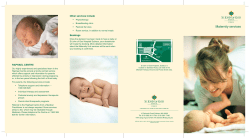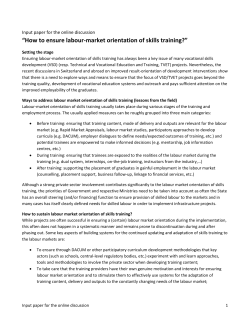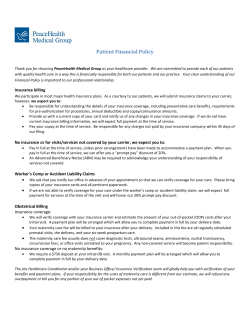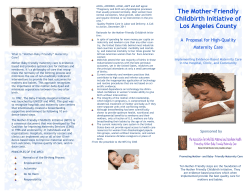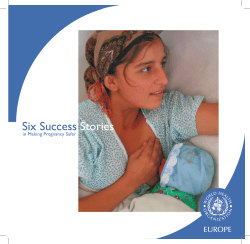
Pregnancy and birth in the Republic of Ireland
Pregnancy and birth in the Republic of Ireland Pregnancy and birth in Ireland C. Déirdre Daly Midwife/Lecturer in Midwifery University of Dublin Trinity College MSc (Health Care Ethics and Law), MSc (Midwifery), BSc (Hons), PG Dip Ad. Ed., Dip. Mid., RM, RGN Pregnancy and birth in Ireland • This session aims to give you – An introduction to the organisation of maternity services in the Republic of Ireland – Definitions related to the antenatal, labour and postnatal periods – Time to question and discuss your forth coming role in being with woman and their partners during labour and birth – Most importantly…an introduction to the needs of women during pregnancy and birth The Organisation of Maternity Care in the Republic of Ireland • Administered by the Health Services Executive (Jan 2005) – Policy developed by Department of Health & Children – All maternity care is free for all women (nonmeans tested) (Public Health care System) – Many women have private health care and opt for private care The Organisation of Maternity Care in the Republic of Ireland • Public health care – – – – – Hospital care Shared care (Hospital or midwife & GP) Obstetric led care Midwives Clinics Independent Midwives • Private Health Care – Obstetric led care – Independent Midwives (provide for home birth) The Organisation of Maternity care in the Republic of Ireland • Other initiatives – – – – Community Midwifery Schemes DOMINO services Home birth Scheme Early discharge from hospital – These services are offered within some Health Board Areas throughout Ireland Maternity hospitals/units: births for 2008 (n=75,421) 1.Letterkenny General Hospital (2059) 2.Sligo General Hospital (1698) 3.Mayo General Hospital Castlebar (1907) 4.Cavan General Hospital (1949) 5.Our Lady of Lourdes Hospital Drogheda (4334) 6.Midland Regional Hospital Mullingar (2889) 7.The Coombe Women’s Hospital (8482) 8.The National Maternity Hospital (9142) 9.The Rotunda Hospital (8799) 10.Mount Carmel Maternity Hospital (1946) 11.Portiuncula Hospital Ballinasloe (2179) 12.University College Hospital Galway (3677) 13.Midlands General Hospital Portlaoise (2246) 14.Limerick City St Munchin’s Maternity Hospital (5473) 15.St Luke’s General Hospital Kilkenny (2188) 16.Kerry General Hospital Tralee (1861) 17.south Tipperary general Hospital Clonmel (1184) 18.Waterford Regional General Hospital (2598) 19.Wexford General Hospital (2423) 20.Cork Unified Maternity Hospital) (8788) St Finbarr’s hospital, Erinville hospital And Mount Carmel hospital united in 2007/8 to form CUMH 20th Century Ireland Maternal Deaths in Ireland Source: Professor Colm O’Herlihy 2009 1950 400 road deaths 400 maternal deaths 2000 400 road deaths 4 maternal death Maternal deaths in Dublin 1940-2004 Year Number of deaths Rate per 100,000 1940-49 328 376/100,100 1950-59 191 149/100,100 1960-69 131 79/100,100 1970-79 57 25/100,100 1980-89 37 17/100,100 1990-99 18 7.5/100,100 2000-04 9 7.5/100,100 Ireland joined UK’s Confidential Maternal And Child health Enquiry (CMACE) in 2009. Next report due March 2011 Births in Ireland through the years Decrease of >33% in 14 years: 1980-1994 Increase of >33% in 14 years: 1994-2008 Year Births Rate 1950 63,565 21.4 1960 60,735 21.5 1970 64,382 21.9 1980 74,064 21.8 1990 53,044 15.1 1991 52,718 15 1992 51,089 14.4 1993 49,304 13.8 1994 48,255 13.5 1995 48,787 13.5 1996 50,655 14 1997 52,775 14.4 1998 53,969 14.6 1999 53,924 14.4 2000 54,789 14.5 2001 57,854 15 2002 60,503 15.5 2003 61,529 15.5 2004 61,972 15.3 2005 61,372 14.8 2006 64,237 15.2 2007 70,620 16.3 2008 75,065 Some statistics: birth numbers for the Republic of Ireland • • • • • • • • • • • • • • • • • • 1979 1980 1981 1989 1994 1996 1997 1998 1999 2000 2001 2002 2003 2004 2005 2006 2007 2008 72,539 74,064 72158 52,018 48,255 50,655 52,775 53,969 53,354 54,239 57, 854 60, 503 61, 517 61, 684 61, 042 64, 237 70,620 75,065 How can antenatal (maternity) care be organised and meaningful for these women? Ireland 2007 Clinical outcomes • Before becoming pregnant… – Are pregnancies planned? – What’s preconception health? – Is it important? What do you think? The menstrual cycle The menstrual cycle Becoming pregnant…? What do (pregnant) women want? Try to identify the needs of women? (What do women want?) Do all women require or want the same type of care? What do you know/what have you heard about? What are the critical aspects ? Not all countries (even counties within Ireland) offer the same type of care… • Consider the needs of these families? Consider the needs of these people…how can we make a positive difference? • • What about women addicted to drugs? • Consider the needs of teenage women? • What are the needs of a woman with HIV? The Aims of Antenatal Care Maternity care is meaningful when it is relevant to the individual woman (and her family’s) needs For many, the priorities will be different Listen to the woman…hear what the woman is saying, hear her needs The aims of antenatal care – To establish open communication and a relationship of partnership with the woman – To provide the woman with information in order to make informed choices – To provide appropriate support to promote physiological, emotional and social wellbeing – To promote and where necessary, improve health – To monitor the maternal and fetal condition and to detect early and promptly treat any deviation – To help the woman prepare for labour and birth and parenting – To help prepare for successful feeding – To prepare for the postnatal period Assessment of maternal health • Health assessment at first antenatal visit • This is the woman’s first encounters with services and with you. – How does she feel? Delighted? Worried? Sick? • • • • • ‘Risk’ factors should be identified and appropriate care planned. Social history: support and social issues Medical: eg diabetes mellitus; epilepsy, thyroid problems; depression Surgical: previous surgery (esp. uterine); previous General anaesthetic Family: – Own – history of diabetes, medical conditions, genetic factors – Partner – genetic factors • Tests – HgB, Rubella immunity, Blood group and rhesus antibodies; HIV, Hep. B., Syphilis, Chicken pox, urinalysis, • Discuss diet • BP Assessment of maternal health • Health assessment at first antenatal visit • Tests – HgB, Rubella immunity, Blood group and rhesus antibodies; HIV, Hep. B., Chicken pox, • Ultrasound scan: confirm pregnancy, number of fetuses • Additional screening tests are available in some centres – (for women who have ‘risk’ factors or on request ) • Timing of tests is important Assessment of maternal health • Health assessment at each subsequent visit • Risk factors should be identified at the first antenatal visit and reviewed at subsequent visits • Review results of previous tests…check all data • Review tests required eg GTT/Rh Antibodies – Check initial tests, check history and review • BP and urinalysis at each visit • Diet • Support issues and social issues • Plan other tests and schedule of visits depending on gestation Clinical assessment • Look at and listen to the woman • • Abdominal examination Inspect – • Palpate – – – • size, shape fetal size, position (important in later weeks i.e. from 36 weeks onwards) liquor volume discuss fetal movements (from 24 weeks) Auscultate – fetal heart • Discuss expected findings with woman • Continuity of carer will increase accuracy of findings • Discuss what’s normal and not normal – – – Vaginal bleeding Prepare for labour (including early labour) Parenthood classes Labour…what is it? • What is Labour? • What do women want? – Individualised care. – Support – partner and professional. – Emotional and psychological care. – Continuity of carer. Factors involved in labour •The fetus, placenta and membranes •The uterus: muscular activity •The bony pelvis •Hormonal influences How is labour defined? • Labour is defined in three stages – First stage • From the onset of regular painful uterine contractions to full dilatation of the cervical os – Second stage • From full dilatation of the cervical os to the birth of the baby – Third stage • From the birth of the baby to the complete birth of the placenta and membranes – Some authors have recognised a fourth stage Signs of onset of labour • The signs of onset of labour are: – Show – Regular painful uterine contractions – Rupture of membranes • They are not definitive signs that labour has commenced How is labour defined? • First stage – From the onset of regular painful uterine contractions to full dilatation of the cervical os – Duration- up to 18 hours (depending on what text you read and where you practice) – Critical aspect: • this stage is about a process that progresses – Second stage • From full dilatation of the os uteri to the birth of the baby – How do you know the first stage has ended and the second stage has begun? – Does the cervix always dilate fully? How do you know? – Can a baby be born before the cervix is fully dilated? Does it matter? Summary of Physiological Changes in the Second Stage of Labour • The contractions are strong and expulsive in nature • The secondary powers, i.e. diaphragm and abdominal muscles aid the expulsive effort. • The pelvic floor is displaced by the advancing fetus • The fetus makes a series of passive movements in the second stage, which are described as the mechanism of labour Women’s Characteristic Behaviour • • • • • Some may verbalise that they are pushing Restlessness Discomfort Desire for pain relief “Get this over as quickly as possible” – Third stage • From the birth of the baby to the complete birth (expulsion is the word used in many texts) of the placenta and membranes • The time can vary greatly…what is considered ‘normal’? (it depends on where you practise) These clots would have been part of the retroplacental clot Slide 41 u1 username, 13/12/2006 • Health and safety of women and fetus • In summary – Assessment of the health and safety of the woman and the fetus is an ongoing process and requires attention to all detail at all times • Labour is dynamic…it is a process…therefore something must be happening… • This element, the assessment of progress, is critical to the well being of woman and fetus The Puerperium The time after childbirth, lasting approx. 6 weeks, during which the anatomic and physiologic changes brought about by childbirth resolve and a woman adjusts to the new or expanded responsibilities of motherhood and non-pregnant life. The changes that take place during the puerperium enable the reversal of adaptations that occurred in pregnancy Postnatal services in the community in Ireland – What happens when the woman gives birth? – How long does she stay in hospital? – What happens then? What voluntary groups/services exist for postnatal women? – – – – – – – Cuidiu, the Irish Childbirth Trust La Leche League Irish Sudden Infant Death Association Irish Stillbirth and Neonatal Death Society Miscarriage Association of Ireland Postnatal Depression Association of Ireland Other specific groups include • • • • Multiple Birth Association Down Syndrome Association Pavee point Associations specific to other conditions – These groups provide social and other support rather than postnatal care In conclusion Listen to women Ensure that every encounter with the woman and her family is positive and benefits the woman References Relevant chapters in core texts. There are a wealth of texts that cover pregnancy and birth and parenthood in greater and lesser detail. You might find the midwifery core texts quite useful and there are several copies of these in the library.
© Copyright 2025
